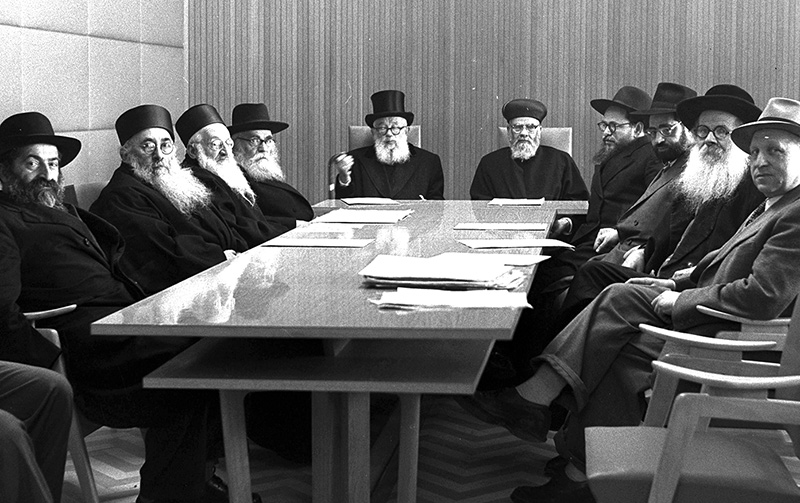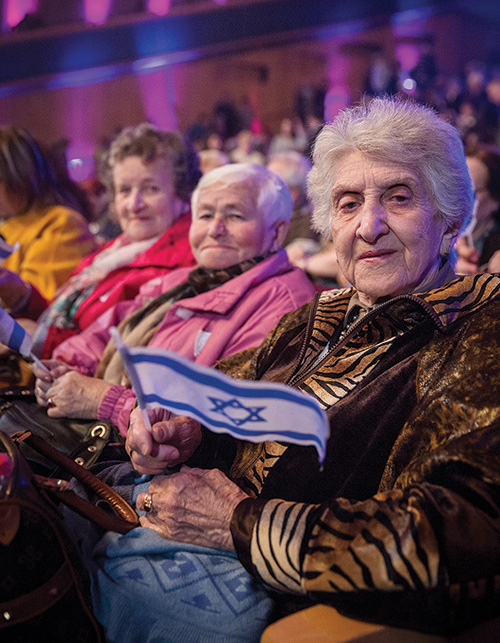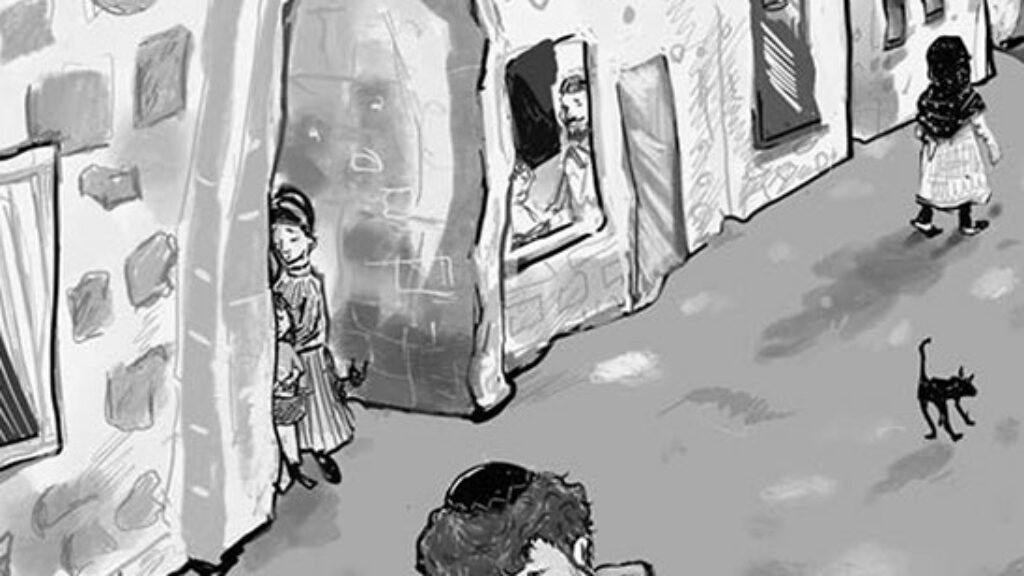Wink-Wink, Win-Win?
Just how great is the conversion crisis in the State of Israel? Consider, for example, the remarks of a well-known conversion court judge in Israel quoted in Michal Kravel-Tovi’s admirable anthropological study of state-sponsored religious conversions in the State of Israel:
Conversion is not only a human need for many of the new immigrants, it is a need of our times, a national, existential matter of the highest level.
The question of conversion has plagued Israeli public discourse since at least 1957, when the National Religious Party protested that roughly 10 percent of immigrants from Russia and Poland were not Jewish under strict halakhic standards. This led to a major coalition crisis and Prime Minister Ben-Gurion’s famous inquiry to 51 scholars, from Rabbi Aharon Kotler to Isaiah Berlin, asking them to define “who is a Jew.” Ben-Gurion underlined the national importance of his query, writing, “In Israel efforts must be made to increase shared and unifying properties and eliminate as far as possible those that separate and divide.” But Israel has never fully resolved this issue, leaving marriage and divorce in the hands of the Orthodox Chief Rabbinate while using much looser standards of Jewish heritage to grant automatic citizenship under the Law of Return.
As Kravel-Tovi notes, the problem has become more acute in the wake of mass immigration from the former Soviet Union over the last generation. These immigrants and their descendants, welcomed after years of Communist oppression, now include roughly 350,000–400,000 Israelis who are fully integrated socially into Israeli society but cannot marry Jews in the State of Israel because they are not Jewish by Orthodox standards. It is estimated that this number of “non-Jewish Jews,” to usesociologist Asher Cohen’s apt term, grows every year by ten thousand, many through immigration and others by virtue of birth to non-Jewish mothers. At this stage, legislative proposals to enact stricter immigration standards under the Law of Return (proposed by the chief rabbis) or to create civil marriage options (proposed by liberal democrats) won’t solve the underlying social chasm created by the fact that halakhically traditional Israelis will not marry these immigrants or their children unless they convert. In fact, surveys show that Israelis, religious and nonreligious alike, believe in religious endogamy to preserve both the Jewish family and the national social framework.
Ben-Gurion himself had a solution for this problem: Anyone who lives in Israel and ties their personal fate to the national destiny of the Jewish people is a Jew. He saw this nationalistic paradigm as the biblical model, exemplified by Moses’s wife, a Midianite, and Ruth the Moabite, ancestor of King David, who never immersed in any mikvah. Yet this model was rejected by Orthodox scholars, Zionist and non-Zionist alike, who affirmed the talmudic model of conversion that required acceptance of the commandments. Ben-Gurion felt the rejection of his approach within his own family. His granddaughter Galia Ben-Gurion, the child of Mary Callow, a Gentile British nurse who married Ben-Gurion’s son, Amos, in 1946 in Liverpool, had trouble getting married in Haifa in 1968 until she and her mother were converted under Orthodox auspices. Callow herself had undergone a speedy conversion by the visiting American Reform rabbi Joachim Prinz in 1946 in response to the future prime minister’s pleas. (Prinz would later write in his memoirs that this conversion violated “every possible ruling” yet worked out as Callow remained loyal to Israel and the Jewish people.) One might see this as a symbolic sign that Ben-Gurion’s model lost, for in this very period the Law of Return was amended to clarify that a non-Jew could change their status only through religious conversion.
Yet today, the majority of Israelis who require conversion under Orthodox standards have no interest in observing the commandments, strictly or otherwise, as confirmed by the extensive interviews done for Kravel-Tovi’s book. State officials, as she documents, may deem conversion as a “national mission,” but as any good liberal will tell you, the state cannot compel worship of the heart. This is the difficult paradox of Israel’s state-sponsored Conversion Administration, which is depicted at length by Kravel-Tovi as a form of “biopolitics,” a term popularized by the French theorist Michel Foucault. In this system, conversion is no longer a matter of individual conscience. Instead,
[I]t constitutes a domain of practice through which the state engages with questions, anxieties, and ideals concerning its population. . . . Through the cumulative demographic effects of the conversion of individual citizens, ideally as many as possible, the Israeli state hopes to shape the composition, size, and boundaries of the national population.
How do the rabbis of the Conversion Administration achieve this goal given the actual motives and expectations of individual converts? Using a term deployed by a prominent Religious Zionist educator, Kravel-Tovi calls the system a “wink-wink” form of conversion. In her depiction, the well-rehearsed conversion candidates learn to dress and speak in a way that will allow the rabbinic judges to ignore the fact that these are generally Israelis who are seeking the social benefits of recognized Jewish identity without undergoing any major internal transformation. “Both sides,” she writes of the convert and the court, “shoulder the burden of constructing believable performances.”
Not all of the rabbis who cooperated with Kravel-Tovi’s research were pleased to read descriptions of the “passwords” and “biographical scripts” used by aspiring converts to convince their rabbinic “audiences” that they were “genuine-enough.” Kravel-Tovi insists, however, that she is not depicting either converts or rabbis as sophisticated deceivers. Instead, each side is balancing a complex set of desires while aiming for a win-win resolution. While primarily seeking acceptance and a greater sense of belonging, the candidates who successfully completed the process often did deepen their appreciation of Jewish culture, history, and even ritual. The rabbis, in turn, could justify their lower conversion standards by citing legal loopholes while taking comfort in the fact that they had strengthened the Jewish identities of Israelis who do not regularly interact with religious society. As she notes, some rabbinic defenders of the system have argued that it is no different than other halakhic legal fictions like selling chametz before Passover. In a world of biopolitics, “winking” is the way the state, its civil servants (rabbis), and its citizens (the converts) maneuver in order to meet formal rules while pragmatically seeking to address complex social dynamics.

A weakness in Kravel-Tovi’s study is that it adopts an entirely external perspective on the Conversion Authority without paying sufficient attention to the ideological battle over the impact of nationalism on Jewish law in general and conversion standards in particular. To understand this debate, we should first note an important insight of Israel’s first Ashkenazi chief rabbi, Yitzhak Herzog: Jewish law has no mechanism for legal naturalization except the acceptance of the yoke of the commandments. In short, if you want to be a member of the tribe, you need to pledge allegiance to the Constitution, namely, the Torah and its 613 commandments. (There is a talmudic precedent for a non-Jew to become a ger toshav, a resident alien, by accepting the seven Noahide laws, but this model was not historically developed, and, in any case, a ger toshav would still not be permitted to marry a Jew.)
Herzog’s premise helps explain the position of many Orthodox authorities, haredi and Religious Zionist alike, that there can be no conversion without a full-fledged intent to observe Jewish law. Just as a country wouldn’t give citizenship to an immigrant who intends to flaunt some of the nation’s laws, so too Judaism does not accept a potential convert who does not pledge total commitment to the norms. Moreover, in religious terms, converting those who are not sincere does no favor to the potential convert, who would immediately be considered a willful sinner upon the completion of this process.
What about the crisis facing the State of Israel, with its hundreds of thousands of “non-Jewish Jews”? Perhaps, some Orthodox authorities speculate, there will eventually be a massive movement of repentance to complete Jewish observance. Alternatively, a few in this camp have even whispered that such Israeli citizens will never feel at home and eventually will move elsewhere. In the interim, those who care about this problem will try to make sure their children do not marry Israelis of questionable halakhic status. It’s an unfortunate situation, but, these rabbis argue, there’s no existential threat. In any case, the bigger danger is the watering down of Judaism and what it means to be a Jew.
A second group of Orthodox leaders agrees that a convert must accept the commandments but asserts that we do not need to deeply scrutinize their religious commitment. They may be accepted as long as they generally intend to observe the basic facets of Jewish law, even if their observance may be lackluster in certain areas. There is, however, significant disagreement within this group as to what fraction of observance is sufficient. This is not surprising, since most of these opinions were framed in response to modern intermarriage in the diaspora. They were aimed at bringing Gentile spouses into (and keeping their Jewish spouses within) the Jewish fold while maintaining social taboos that spurned intermarriage. No definitive consensus emerged within this group about the minimum requirements, as each rabbinic authority decided for himself what level of commitment was sufficient.
Needless to say, not every conversion done under these circumstances inspired lasting commitment, causing angst in their converting rabbis along with further opprobrium from the more conservative legal camp. Many of the leaders of Israel’s Conversion Authority have placed themselves within this pragmatic school of thought. It’s therefore not shocking that Kravel-Tovi found them ambivalent about the goals and success of their program, especially since her interviews showed that the converts usually returned to their secular lifestyles once they had completed the conversion process.

Yet if the conservative position pulls these officials in one direction, a third, smaller and more radical school of thought pulls them in another. This is a nationalist position that has been adopted by a few previous chief rabbis but never embraced by the rabbinic mainstream. Instead of arguing for legal fictions or looser conversion standards to meet the “needs of the hour” like their diaspora predecessors did, this group postulates a revised halakhic definition of Jewish peoplehood that reflects the new reality of the State of Israel.
Rabbi Ben-Zion Uziel, Israel’s first Sephardi chief rabbi, took a prophetic approach, following the prophet Ezekiel, who famously declared:
My flock is scattered all over the face of the earth. . . . My flock has been a prey for all the wild beasts. . . . As a shepherd seeks out his flock when some in his flock have gotten separated, so I will seek out My flock. I will rescue them from all the places to which they were scattered on a day of cloud and gloom. (Ez. 34:6, 8, 12)
Do we expect all of these sheep to have remained entirely separate in their own herds, like in Teaneck and Golders Green? Or is it more likely that they have blended in among the high grass of pastures in cities like Leningrad and Odessa? If the latter, then it’s likely that their redemption will bring along other people with them, a point that had already become accepted by 1957. Religious Zionists speak of the return to Zion as the fulfillment of these biblical prophecies, yet, on this argument, they may not have fully internalized the complex historical implications of kibutz galuyot (the ingathering of the exiles).
Two other chief rabbis who followed this general line of argument were Rabbis Isser Unterman and Shlomo Goren. Unterman had been the chief rabbi in Liverpool for 23 years before emigrating to Palestine in 1946. In England, Unterman took a strict stand regarding converting children of Jewish men and Gentile women, as he thought it would encourage intermarriage. As Tom Segev has recently documented, when Ben-Gurion asked Unterman to convert Callow in 1946, he refused and told Ben-Gurion that she had a great deal to learn before she could be eligible to convert. Yet when the first immigrant waves from the Soviet Union began to arrive in the early 1970s, Unterman argued for absorbing those of Jewish lineage, particularly when dealing with minors whose conversion is implemented through a rabbinic court order, since they are too young to accept upon themselves the commandments. He justified this by invoking a notion of preserving zera Yisra’el (Jewish seed), an ethnic term first used by the 19th-century proto-Zionist Rabbi Tzvi Hirsch Kalischer.
Yet this lenient approach was only really implemented by Unterman’s successor, Rabbi Shlomo Goren, who established the state conversion centers to teach prospective converts. (It was also Goren who would officiate at Callow’s daughter’s wedding in 1968, drawing fierce criticism from his colleagues.) Goren argued that the Babylonian Talmud’s more stringent attitude toward conversion reflected the fact that it was composed in exile. In contrast, the Jerusalem Talmud set a more lenient precedent, since it presupposed that converts there were more easily integrated into Jewish culture. Incredibly, he even cited the Hasmonean forced conversion of the Idumeans, documented by Josephus, as a historical example of religious integration through national absorption. The most radical aspect of these claims was his search for guiding legal precedents coming from cases or sources when Jews had national sovereignty, as opposed to those recorded by the canonical Babylonian Talmud and its commentaries.
What ultimately unites these Zionist lines of halakhic reasoning is the belief that the responsibility for running a sovereign Jewish nation must make a difference in the way that Jewish law functions. This has always been a sensitive question for Religious Zionists as they addressed issues of building a modern state. Must the lands truly remain fallow during the sabbatical year? Can electricity plants or dairy farms remain unstaffed over the Sabbath? Israeli government coalitions have fractured over such disputes. Yet no question is as sensitive as laws relating to personal status. If your neighbor eats a prohibited cucumber during the sabbatical year, that’s a shame. If your son marries a woman whose conversion isn’t legitimate, that’s a tragedy for generations.
Yet the nationalist line of halakhic thinking asserts that even in this most sensitive area of personal status, the Zionist project impacts religious standards. For if you do nothing about the crisis of “Jewish non-Jews,” there will be a concomitant crisis of Jewish identity, which is critical for national cohesion. Conversion standards must be different when people are entering a nation and not just a religion. Foreigners, whether as immigrants or converts, become assimilated into the broader culture. This was precisely the problem of conversion in the diaspora, where Jews were a small minority, but it is the solution in today’s Israel, which integrates Judaism into daily life. After all, Israeli citizens observe many traditional Jewish norms by default. They purchase kosher food in supermarkets, speak Hebrew, mark the Jewish festivals as national holidays, celebrate symbolically significant rituals like circumcisions and the Passover Seder, and place mezuzot on their doorposts. Perhaps most significantly, they serve in the army and protect the Holy Land. There may be a “wink-wink” approach in the conversion courts, but it is in the service of an emphatic head nod to the ingathering of the exiles, the miraculous restoration of Jewish sovereignty, and the creation of a Jewish civic culture.
Kravel-Tovi believes that the rabbis that she interviewed are finding wiggle room within the “socio-institutional reality of the conversion procedure,” with their “wink-winks” and “life scripts.” Perhaps this is true, but I suspect that many also understand that the ultimate result is a redefinition of what it means to become naturalized as a citizen of the Jewish nation. Nonetheless, they and the rest of the Zionist religious establishment have never felt entirely comfortable with allowing national considerations to impact religious norms. In part, this is because they are caught between the religious criticism of anti-Zionist haredi detractors on the one hand and the pressure of secular politicians on the other. More fundamentally, they shrink from allowing political considerations to undermine spiritual values—they worry that Ben-Gurion’s pragmatic nationalist vision will ultimately win. I favor a recent initiative undertaken by the independent rabbinic organization Giyur Ke-halakha to convert Israeli “non-Jewish Jews” while they are children, utilizing more lenient protocols established in the Talmud for minors who are not responsible for complete legal observance because they are under the age of bar or bat mitzvah. This will help, but it is not an overall solution. Upon finishing Michal Kravel-Tovi’s important, challenging book, one realizes that there is no reason for great optimism. Despite 60 years of government intervention, the national mission of conversion is failing. The potential converts are not arriving en masse, the rabbis are not enthusiastically greeting those who do; the problem continues to get worse.
Suggested Reading

Even If the Ship Is Not Sinking
Some of the displaced persons who made their way from Germany to the new State of Israel felt more displaced in their new homeland than in the camps they left behind.

Radical Kindness and Heroic Dogs: A New Anthology of Yiddish Children’s Literature
Honey on the Page, like the best anthologies, is an eye-opening work of literary history, gleefully introducing a sea of lightly known authors through both their work and through meticulously crafted biographical sketches.
King James: The Harold Bloom Version
There may be a thousand facets to the Torah, but does Harold Bloom simply misunderstand the King James Bible?

A Tale of Two Cohens: Purim in Montreal
Lyon Cohen wrote and starred in Congregation Shaar HaShomayim's first Purim spiel in 1885--and then led the Montreal Jewish community for half-century. His grandson Leonard didn’t exactly follow his lead, but he does have a big grin in the cast photo of the 1947 Purim Spiel.
Comments
You must log in to comment Log In